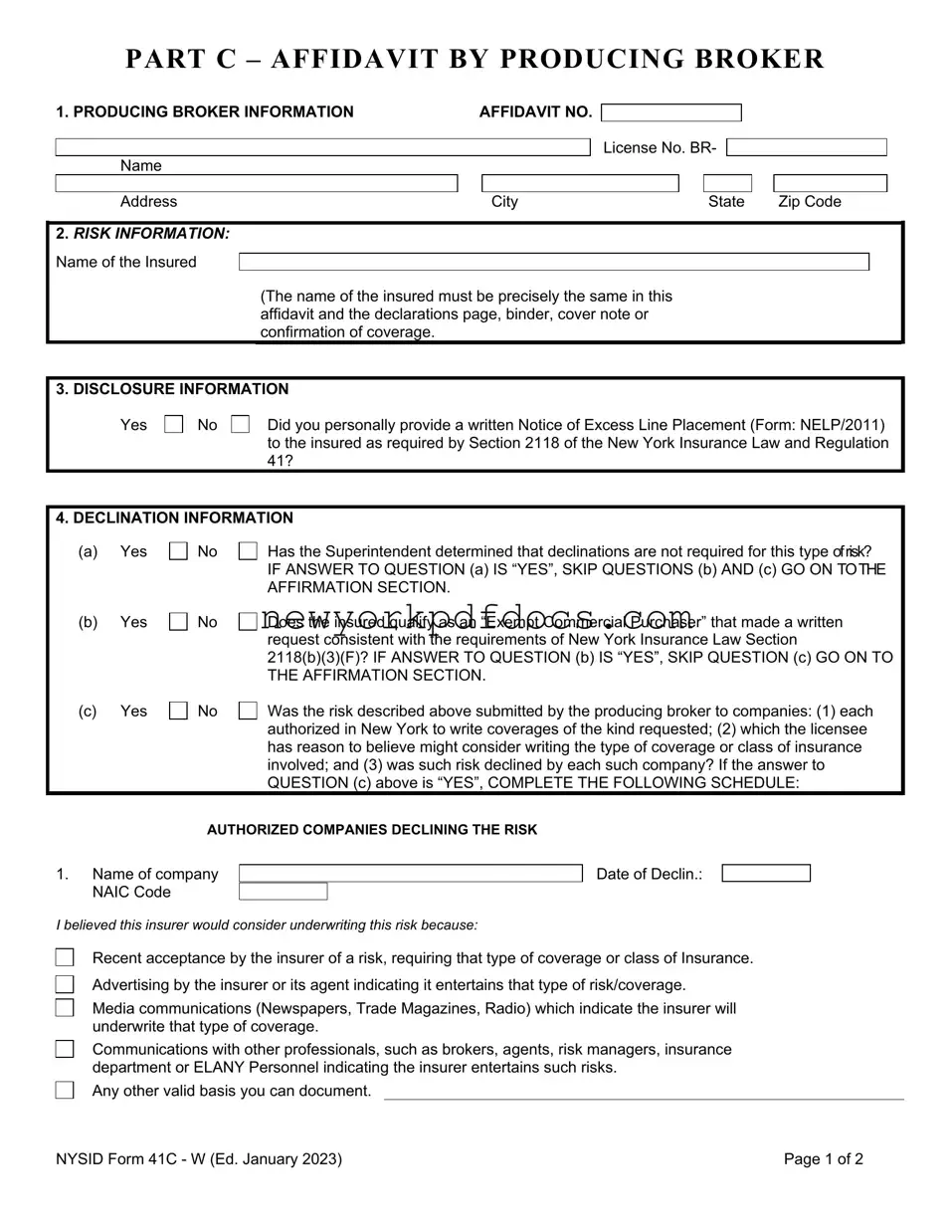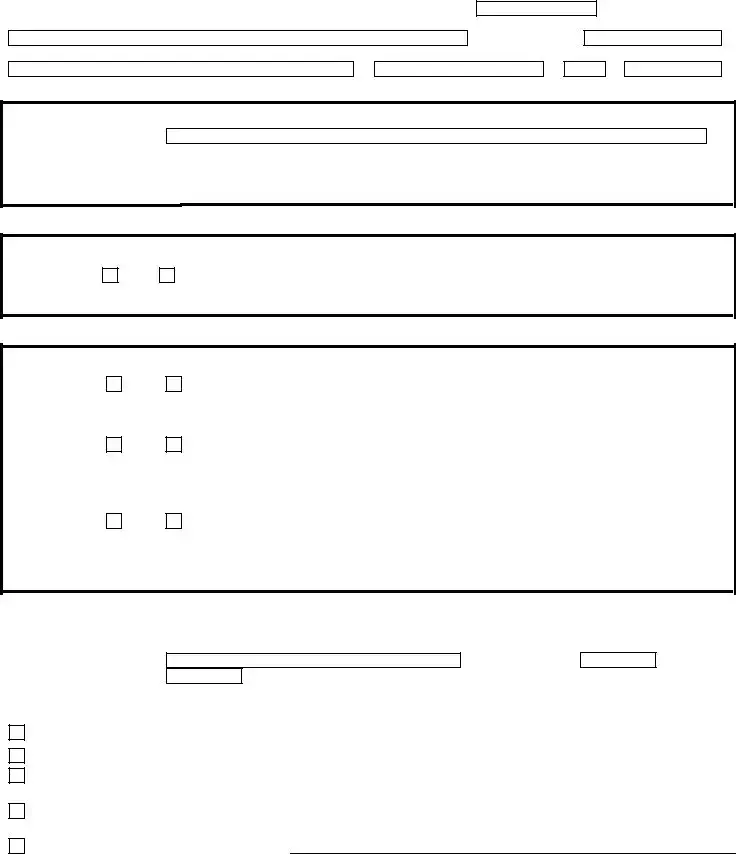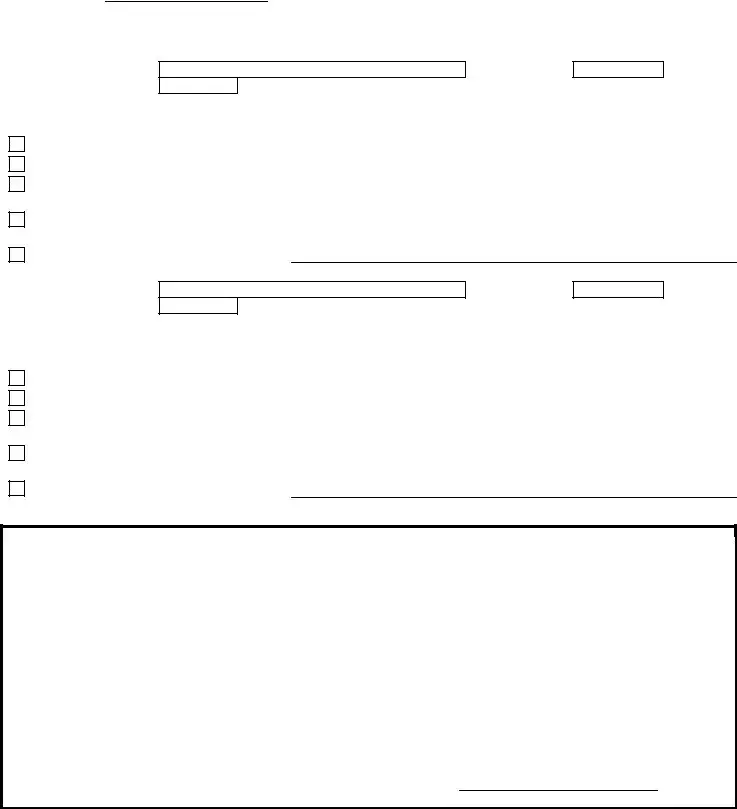PART C – AFFIDAVIT BY PRODUCING BROKER
1. PRODUCING BROKER INFORMATION |
AFFIDAVIT NO. |
License No. BR-
CityState
2.RISK INFORMATION: Name of the Insured
(The name of the insured must be precisely the same in this affidavit and the declarations page, binder, cover note or confirmation of coverage.
3. DISCLOSURE INFORMATION
Did you personally provide a written Notice of Excess Line Placement (Form: NELP/2011) to the insured as required by Section 2118 of the New York Insurance Law and Regulation 41?
4. DECLINATION INFORMATION
Has the Superintendent determined that declinations are not required for this type ofrisk? IF ANSWER TO QUESTION (a) IS “YES”, SKIP QUESTIONS (b) AND (c) GO ON TOTHE AFFIRMATION SECTION.
Does the insured qualify as an “Exempt Commercial Purchaser” that made a written request consistent with the requirements of New York Insurance Law Section 2118(b)(3)(F)? IF ANSWER TO QUESTION (b) IS “YES”, SKIP QUESTION (c) GO ON TO THE AFFIRMATION SECTION.
Was the risk described above submitted by the producing broker to companies: (1) each authorized in New York to write coverages of the kind requested; (2) which the licensee has reason to believe might consider writing the type of coverage or class of insurance involved; and (3) was such risk declined by each such company? If the answer to QUESTION (c) above is “YES”, COMPLETE THE FOLLOWING SCHEDULE:
AUTHORIZED COMPANIES DECLINING THE RISK
1.Name of company
NAIC Code
I believed this insurer would consider underwriting this risk because:
Recent acceptance by the insurer of a risk, requiring that type of coverage or class of Insurance. Advertising by the insurer or its agent indicating it entertains that type of risk/coverage.
Media communications (Newspapers, Trade Magazines, Radio) which indicate the insurer will underwrite that type of coverage.
Communications with other professionals, such as brokers, agents, risk managers, insurance department or ELANY Personnel indicating the insurer entertains such risks.
Any other valid basis you can document.
NYSID Form 41C - W (Ed. January 2023) |
Page 1 of 2 |
PART C – AFFIDAVIT BY PRODUCING BROKER
AFFIDAVIT NO.
AUTHORIZED COMPANIES DECLINING THE RISK
2.Name of Company NAIC Code
I believed this insurer would consider underwriting this risk because:
Recent acceptance by the insurer of a risk, requiring that type of coverage or class of Insurance. Advertising by the insurer or its agent indicating it entertains that type of risk/coverage.
Media communications (Newspapers, Trade Magazines, Radio) which indicate the insurer will underwrite that type of coverage.
Communications with other professionals, such as brokers, agents, risk managers, insurance department or ELANY Personnel indicating the insurer entertains such risks.
Any other valid basis you can document.
3.Name of Company NAIC Code
I believed this insurer would consider underwriting this risk because:
Recent acceptance by the insurer of a risk, requiring that type of coverage or class of Insurance. Advertising by the insurer or its agent indicating it entertains that type of risk/coverage.
Media communications (Newspapers, Trade Magazines, Radio) which indicate the insurer will underwrite that type of coverage.
Communications with other professionals, such as brokers, agents, risk managers, insurance department or ELANY Personnel indicating the insurer entertains such risks.
Any other valid basis you can document.
AFFIRMATION
I, |
|
, am the licensee or sublicensee of the named broker |
in Section 1 of this affirmation and I hereby affirm under penalties of perjury that all of the information contained herein is true to the best of my knowledge and belief.
Signature of Affiant |
|
Date |
NYSID Form 41C - W (Ed. January 2023) |
Page 2 of 2 |


